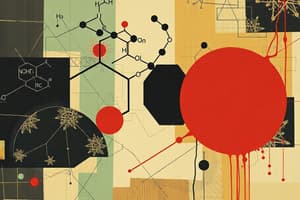Podcast
Questions and Answers
What type of forces are responsible for the increase in boiling point and melting point of alkanes as molecular weight increases?
What type of forces are responsible for the increase in boiling point and melting point of alkanes as molecular weight increases?
- Ionic forces
- Hydrogen bonding
- Dispersion forces (correct)
- Covalent bonds
What is the role of three-dimensional structures in determining the properties and biological behavior of molecules?
What is the role of three-dimensional structures in determining the properties and biological behavior of molecules?
- They determine reactivity
- They control atomic weight
- They affect color
- They influence shape and interactions (correct)
Which type of bond allows rotation around carbon-carbon single bonds in open-chain molecules?
Which type of bond allows rotation around carbon-carbon single bonds in open-chain molecules?
- Double bond
- Polar covalent bond
- Single bond (correct)
- Triple bond
In the context of ethane, what do conformations refer to?
In the context of ethane, what do conformations refer to?
What allows for rotation around carbon-carbon single bonds in ethane?
What allows for rotation around carbon-carbon single bonds in ethane?
What is the correct term for the partial structure of straight-chain alkanes?
What is the correct term for the partial structure of straight-chain alkanes?
What does the suffix in the IUPAC naming system of alkanes identify?
What does the suffix in the IUPAC naming system of alkanes identify?
What is the purpose of numbering the atoms in the parent chain during alkane naming?
What is the purpose of numbering the atoms in the parent chain during alkane naming?
What is the recommended approach in naming alkanes regarding the number of substitutions?
What is the recommended approach in naming alkanes regarding the number of substitutions?
How should substituents on the same carbon be treated when numbering during alkane naming?
How should substituents on the same carbon be treated when numbering during alkane naming?
What do the terms 'primary', 'secondary', 'tertiary', and 'quaternary' refer to in organic chemistry?
What do the terms 'primary', 'secondary', 'tertiary', and 'quaternary' refer to in organic chemistry?
What is a functional group?
What is a functional group?
What determines the chemistry of every organic molecule?
What determines the chemistry of every organic molecule?
Which general formula represents alkanes?
Which general formula represents alkanes?
What are isomers?
What are isomers?
What are constitutional isomers?
What are constitutional isomers?
What suffix is added to identify straight-chain alkanes?
What suffix is added to identify straight-chain alkanes?
What does the prefix di- indicate in the naming of alkanes?
What does the prefix di- indicate in the naming of alkanes?
What does the term 'paraffins' mean in Latin?
What does the term 'paraffins' mean in Latin?
How do alkanes react with oxygen under appropriate conditions?
How do alkanes react with oxygen under appropriate conditions?
What happens when a mixture of alkanes and Cl2 is irradiated with ultraviolet light?
What happens when a mixture of alkanes and Cl2 is irradiated with ultraviolet light?
What is the systematic name for 3-isopropyl-2-methylhexane?
What is the systematic name for 3-isopropyl-2-methylhexane?
What type of products result from the reaction of methane with oxygen?
What type of products result from the reaction of methane with oxygen?
Study Notes
Naming Alkanes
- When two or more different substituents are present, write them in alphabetical order.
- When two or more identical substituents are present, use the multiplier prefixes di-, tri-, tetra-, penta-, and so forth.
Properties of Alkanes
- Alkanes are referred to as paraffins, meaning "little affinity" in Latin.
- They show little affinity for other substances and are chemically inert to most laboratory reagents.
- They react with oxygen, halogens, and a few other substances under the appropriate conditions.
- Alkanes occur during combustion in an engine or furnace when used as a fuel.
Functional Groups
- A functional group is a group of atoms within a molecule that has a characteristic chemical behavior.
- These structural features allow compounds to be classified into families.
- A given functional group behaves in nearly the same way in every molecule.
- The chemistry of every organic molecule is determined by the functional groups it contains.
Alkanes and Alkane Isomers
- Alkanes are compounds of carbon and hydrogen that contain only carbon-carbon single bonds.
- The general formula for alkanes is CnH2n+2, where n is an integer.
- Alkanes can be straight-chain or branched-chain.
- Isomers are compounds that have the same molecular formula but different structures.
- Constitutional isomers have the same kinds and numbers of atoms connected in different arrangements.
Stereochemistry
- Stereochemistry refers to the three-dimensional aspects of molecules.
- Three-dimensional structures determine the properties and biological behavior of molecules.
- s-bonds are cylindrically symmetrical, allowing rotation around carbon-carbon bonds in open-chain molecules.
Conformations of Ethane
- Conformations refer to the three-dimensional shape of a molecule.
- Conformational isomers are molecules that adopt different arrangements.
Alkyl Groups
- An alkyl group is the partial structure (the branch) of straight-chain alkanes.
- Replace –ane with –yl to form an alkyl group.
Naming Alkanes
- Systematic nomenclature is devised by the International Union of Pure and Applied Chemistry (IUPAC).
- A name has four parts: prefix, parent, locant, and suffix.
- To name an alkane, follow four steps: find the parent hydrocarbon, number the atoms in the parent chain, identify and number the substituents, and apply the IUPAC rules.
Studying That Suits You
Use AI to generate personalized quizzes and flashcards to suit your learning preferences.
Description
Test your knowledge on organic compounds, alkanes, and functional groups. Learn about the characteristic chemical behavior of different groups of atoms within molecules, and how they determine the classification of compounds into families.




